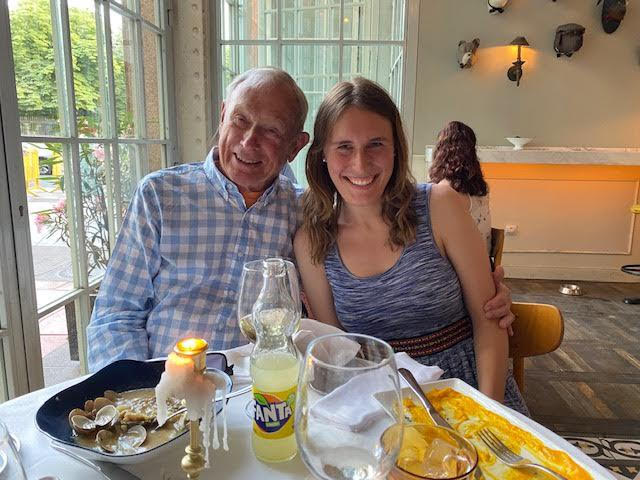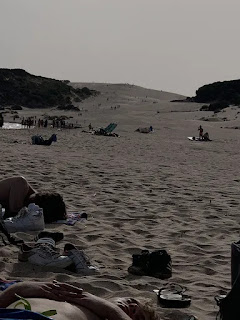Creativity Through Eye Movements
When I was helping out in the art workshop at ACPACYS, I had the opportunity to get to know a woman named Machu. Although I did not know her well, I heard a lot about her from staff members at ACPACYS. I learned from the staff that Machu has disabilities that prevent her from being able to speak or move her hands, but her disabilities are only physical. She uses eye movements to communicate, thus it is easiest to ask her "yes" or "no" questions. She looks up for "yes" and down for "no."
Shortly after I arrived in the morning on Monday, one of the caretakers brought Machu into the room and put her next to me. I smiled at her and said hello. Her face lit up and I could that she has the type of smile that can put anyone in a good mood. I asked her if she was doing well and she looked up to indicate "yes." I then showed her the recycled can I was painting and asked her if she liked the pale blue color. She once again looked up to indicate "yes". After I made a several pompoms, I asked Machu which one she liked best. She looked at one of the pompoms to indicate her answer choice.
As I continued working on the art for the exhibition that week, I got to enjoy's Machu's company. All I could do was look up at her every now and then, smile, and ask how she was doing. I also told her some things about myself such as where I was from and my hobbies. However, I wished I could have a full conversation with her that didn't seem so one-way, and I felt guilty because I wasn't able to do that.
At one point, Machu looked intently at a water bottle. I asked her if she was thirsty and she said looked down for "no." Confused, I asked the instructor for clarification. The instructor explained that another member in the workshop was angry and when a person is angry, a common expression in Spain is telling them to drink water, which is a way of encouraging them to calm down. For that reason, Machu looked at a water bottle.
At another point, Machu was making lots of eye movements, and I wasn't sure exactly what she wanted to communicate. I asked the instructor for help, and she explained to me that Machu was looking at the design I was painting on the recycled can as well as the heart shapes on the other side of the table to indicate that she loved my design. This boosted my confidence because I was worried my design wasn't good enough, but Machu assuaged that fear with her encouragement. Machu is the type of person who enjoys celebrating others. Even though she did not have the physical abilities to work on art projects, watching others doing the projects and enjoying themselves brings her joy.
Although Machu was not able to create art projects using her hands, she demonstrated her resourcefulness and creativity through her eye movements. She is able to use objects in her surroundings as communication tools in order to contribute to a conversation. Even though her surroundings change, Machu is able to adapt and come up with relevant contributions to conversations. Through her communication she is making connections between vision and audition. She has a talent for listening to a conversation and thinking about how that conversation can be represented visually using the limited objects around her.
After the workshop ended for the week, I sat down with the instructor in order to learn more about Machu's abilities and how she communicates. The instructor had known Machu for years and explained that she can understand Machu's eye movements well now that she has had lots of practice. Although when talking directly to Machu, it is easiest to provide her with answer choices (either "yes" or "no") or objects that she can look at, paying close attention to Machu's eye movements when she is listening to a conversation can provide valuable insight into her thoughts. The instructor emphasized how Machu is a beautiful human being who is always looking out for others. For example, does not go on the ACPACYS trips to the beach because she wants the organization to give priority to those who don't have family or friends nearby to take them like she does.
I asked if Machu had ever used an AAC (augmentative and alternative communication) tablet, and the instructor said no. I then asked if Machu wanted a tablet for that purpose. The instructor explained that Machu views AAC tablets as a luxury, but she is perfectly content without one. She does not want her family to invest such a large amount of money in something that could easily break or get lost. Instead, she prefers her family to spend money on things that can help more people than just her. I was amazed by her selflessness; she would rather go through life not being able to communicate fully than have her family spend a large amount of money just for her.
The instructor's family and Machu's family are close friends given that they have both been at ACPACYS for years and they see each other every summer during their vacation. She told me that her daughter began calling Machu "Auntie" from a young age because of the loving person that she is. Machu is one of her daughter's biggest cheerleaders and support systems. Her heart is so big that she doesn't need to speak or move her body for others to feel the love.
After I met Machu, I met with my supervisor to see if there was a way we could fundraise to get an AAC device for her. Unfortunately, this was not a possibility because fundraisers need to benefit all of the members at ACPACYS, as everyone's needs are equally important. Although doing a fundraiser just for Machu was not an option, my supervisor did explain that ACPACYS was in the process of writing a grant for a large tablet that can be used for interactive and educational activities and a computer be controlled by eye movements. I decided to assist in the writing of this grant and enjoyed learning about the process. I am hoping that Machu will be able to use the technology if ACPACYS receives the grant and that she will not longer be limited to "yes" or "no" questions.


Comments
Post a Comment